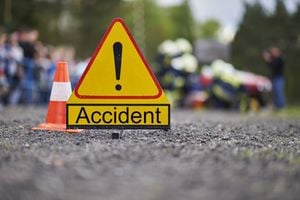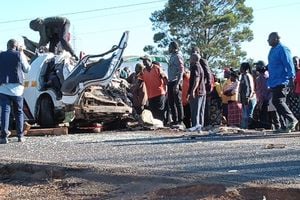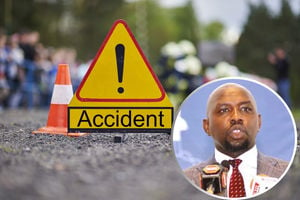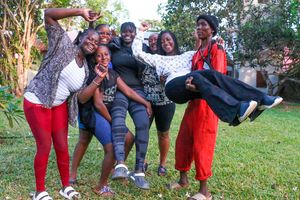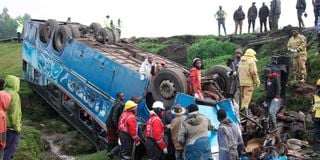
The scene of a road crash which claimed two lives with 21 others injured after a Nairobi-bound bus overturned along the Eldoret- Nakuru highway on August 24, 2024.
Road slaughter continued to rise in Kenya in 2024, with at least 400 more people being killed compare to the previous year.
Data from the National Transport and Safety Authority (NTSA) shows that at least 4,748 people lost their lives on the roads between January 1 and December 31, 2024 compared to 4,324 the year before.
In December alone, at least 470 Kenyans died across the country, a 10 per cent increase on 2023 toll, making it one of the deadliest months in Kenyan history.
In the last three months of the year — between October and December — passengers, pedestrians, motorcyclists and their pillion riders bore the brunt of the killer roads, culminating in nearly 800 deaths compared to 450 drivers and riders.
There are about 2.5 million registered boda bodas in the country, of which 1.8 million are active. Nairobi County was the main scene of the bloodletting, claiming more than 130 victims in last three months of the year.
For the full year, at least 560 lost their lives in the city county, with Kiambu county recording the second highest number of fatalities, at 420.
Other counties that recorded high numbers of road deaths during the year were Nakuru county with 420 while Machakos saw a decrease, recording less than 200 deaths compared to at least 208 deaths in 2024.
Mandera County reported no single road-crash-related deaths during the period under review, followed by Wajir and Samburu with one fatality each.
Outering, Eastern Bypass, Thika Superhighway, Waiyaki Way, and Northern Bypass are among the roads that recorded the highest number of fatal accidents in Nairobi.
The month-by-month analysis shows that December 2024 recorded the highest number of fatalities, with 466 people killed, up from 423 in 2023, an increase of 10.17 per cent. This makes December the deadliest month of the year for road users.
January saw a relatively small increase, with 389 deaths compared to 379 in 2023. February saw a sharper increase with 374 fatalities, a 10 per cent rise on the 340 fatalities recorded in the same month the previous year.
March recorded 403 fatalities, up from 389 in 2023, an increase of 3.6 per cent, while April saw an increase of 8.68 per cent, with 388 fatalities compared to 357 the previous year.
May saw a slight increase, with 341 fatalities in 2024 compared to 340 in 2023.
June was the only month to saw a decrease, with the number of fatalities falling from 439 in 2023 to 411 in 2024, a decrease of 6.38 per cent.
However, this downward trend was short-lived as July saw a sharp increase of 17.54 per cent, with 382 deaths compared to 325 in 2023.
August and September also saw significant increases— August recorded 437 deaths, compared to 372 in 2023. Similarly, September recorded 402 fatalities compared to 338 the previous year, an increase of 18.93 per cent.
October recorded 382 fatalities in 2024, an increase of 15.76 per cent on the 330 recorded in 2023, while November saw one of the largest increases, with 373 fatalities compared to 292 in 2023.
NTSA data also listed the killer roads in Kenya, with those in Nairobi leading the pack. Outering, Eastern Bypass, Thika Superhighway, Waiyaki Way, and Northern Bypass are among the roads that recorded the highest number of fatal accidents in the capital.
NTSA data also reveals that Rift Valley region has the highest concentration of blackspots, with 13 locations identified as hazardous, while North Eastern and Eastern have the least.
Many of Rift Valley's blackspots are on the Nairobi-Nakuru-Eldoret highway, part of the Northern Corridor that connects Kenya to Uganda, South Sudan, Rwanda and Burundi. This route is often crowded with cargo transport vehicles and passenger traffic, creating a deadly mix.
The highway, grimly nicknamed the “Highway to Hell” by some, has recorded 42 fatalities since January 2024.
Another notorious area is the Salgaa section, spanning Ngata Bridge to Sachangwan. The more than 20-kilometre Salgaa stretch could easily be termed as the most notorious blackspot in the country, if the number of road accidents that have happened there is anything to go by.
On August 20, 2024, 13 people died at the Salgaa blackspot on the Nakuru-Eldoret highway.
To mitigate road carnage on this stretch of road, a temporary concrete barrier was constructed by a Chinese firm. The wall that only covers a part of the road has seen a decline in the number of crashes.
Statistics from the local Traffic Accident department show that the Sobea-Salgaa section claims at least five lives every month. Head-on collisions and hit-and-run accidents caused by careless are common.
Other blackspots in the southern Rift are Mau Summit-Londiani, Timboroa-Makutano, and Pinyiny Hills on the Narok-Maai Mahiu road.
The Bomet-Narok road alone has claimed over 15 lives since 2025 began. On January 9, some 15 people died and over 30 people were left nursing injuries in an accident at Twin Bridge near Mau Summit.
At the Olonin bridge blackspot on the Bomet-Narok road, six people died on December 15, 2024.
In the Mount Kenya region, Nithi Bridge on the Meru-Embu road is the most dangerous blackspot and has claimed lives since its commissioning in 1985.
In September 2024, a head-on collision between a 10-seater van and pickup truck killed12 people. The accident came after two others that claimed more than 10 lives earlier in the year.
Other blackspots in the region include the Kiganjo-U stretch on Nyeri-Narumoru Road and Limuru-Uplands section.
Thika Blue Post-Sagana Bridge Road, Mlima Swara on the Nyeri-Nairobi highway, Kianugu section on Nyahururu road and the Kiambu–Muthaiga road are some of the other killer roads in the region.
Others are Makutano-Kutus stretch on Makutano-Embu road and Makongeni area on Thika-Garissa road.
In Nyanza, hotspots such as Awasi on the Kisumu-Kericho highway, Kiboswa on Kisumu-Kakamega road, and Daraja Mbili in Kisii continue to record accidents.
The Western region’s killer sections include Kaburengu, Yala Bridge, and Chavakali on the Kakamega-Chavakali road, which saw a fuel tanker crashing and killing 10 people on November 15, 2024.
In the Coast, blackspots on the Mombasa-Nairobi highway include the Maungu-Voi stretch, Mazeras-Miritini, and sections of the Mombasa-Nairobi highway, such as Chumvi, Salama - Sultan Hamud Road when descending Mlima Kiu, Mtito to Tsavo River Stretch.
Others according to NTSA are Jiwe Tanga in Malindi, Waa area on the Kwale -Matuga junction and Navy Junction (Mtongwe Junction) along the Lunga Lunga -Likoni road.
The Eastern region is among the safest in the country in terms of road carnage. However, it still has dangerous spots and transport routes, such as the Machakos-Wamunyu Road Section, Kithangathini at Machakos, Wamunyu Road, Mlololongo-Small World Club Junction, Namanga, and Mto wa Mawe bridge.
North Eastern has the fewest blackspots on Garissa-Madogo and Modo.
According to NTSA Director General George Njao, the authority will streamline public transport in the country.
Mr Njao said many crashes occur on the Northern Corridor, which drives the large percentage of fatalities. According to the NTSA, counties situated along the Northern Corridor stretching from Mombasa to Malaba account for 40 per cent of the more than 4,000 lives lost on Kenyan roads every year.
He said that the majority of fatalities are not passengers but pedestrians, accounting for 38 percent of all deaths in Nairobi county alone.
The second-highest number of fatalities was attributed to motorcyclists using these roads.
"Analysis indicate that the most affected category of road users are pedestrians at 38 per cent followed by Motorcyclists at 25 per cent," he stated.
For the first time, the NTSA report faulted the state through its agency, the Kenya National Highway Authority (Kenha), for the poor state of some roads and the reckless manner in which government vehicles are driven.
“Current road designs prioritise the needs of motorised vehicles and do not adequately consider the safety of vulnerable road users such as cyclists, pedestrians, and motorcyclists,” said Mr Njao.
According to the NTSA, road carnage costs the Kenyan economy about Sh450 billion every year.
"The brunt of this burden falls disproportionately on trauma victims and their families, while hospitals and emergency services also bear the burden," it said.

